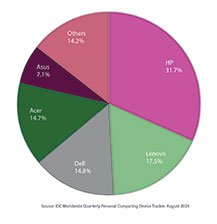85% of women in India miss out on salary hikes and promotions because of their gender: LinkedIn
Digital Edge Bureau 02 Mar, 2021 0 comment(s)
Ruchee Anand, Director, Talent and Learning Solutions, LinkedIn India: Women face more gender bias during COVID-19 times
On the occasion of International Women’s Day 2021, LinkedIn has come out with the Opportunity Index 2021 report, which reveals that the COVID-19 pandemic further accentuates the existing gender gaps. LinkedIn’s findings show that 9 in 10 (89 percent) women state they were negatively impacted by the COVID-19 pandemic. This year’s report dives deep to understand how women perceive opportunities, and how the gender gap is further slowing down career progress for working women in India amid the pandemic. India’s working women battle strongest gender bias across APAC.
However, the report shows that even though 66 percent of people in India feel that gender equality has improved compared to their parents’ age, India’s working women still contend the strongest gender bias across Asia-Pacific countries. When asked about their reasons for being unhappy with opportunities to advance in their careers, 1 in 5 (22 percent) working women in India said their companies exhibit a ‘favourable bias’ towards men at work, when compared to the regional average of 16 percent.
“Gender inequality at work and added domestic responsibilities amid the pandemic have collectively made women’s jobs more vulnerable at this time. As COVID-19 continues to widen these gaps, this year’s LinkedIn Opportunity Index report suggests that it is the need of the hour for organisations to reimagine their diversity practices and offer greater flexibility to caregivers, in order to increase female participation in the workforce. Reduced and flexible schedules, more sabbaticals, and new opportunities to upskill and learn are critical offerings that can help organizations attract, hire, and retain more female talent”, says Ruchee Anand, Director, Talent and Learning Solutions, LinkedIn India.
The LinkedIn Opportunity Index 2021 highlights the difference in perception of available opportunities in the market for men and women in India. While 37 percent of India’s working women say they get fewer opportunities than men, only 25 percent of men agree with this. This disparity in perception is also seen in conversations about equal pay, as more women (37 percent) say they get less pay than men, while only 21 percent men share this sentiment.
A deeper analysis shows that more women in India have experienced the impact of gender on career development when compared to the APAC region. In India, more than 4 in 5 working women (85 percent) claim to have missed out on a raise, promotion, or work offer because of their gender, compared to the regional average of 60 percent.
In India, the top three job opportunities sought by both men and women are job security, a job that they love, and good work-life balance. But despite having similar goals, more women (63 percent) think a person’s gender is important to get ahead in life, when compared to men (54 percent).
Consumer sentiment from the report shows that more than 7 in 10 working women (71 percent) and working mothers (77 percent) feel that managing familial responsibilities often comes in their way of career development. In fact, about two-thirds of working women (63 percent) and working mothers (69 percent) said they have faced discrimination at work because of familial and household responsibilities.
While job security is critical for working women across India, women are laying more emphasis on the type of employer they choose to work with, the recognition they will receive for the work they do, and on the skills that will be utilised on the job. As per LinkedIn’s findings, they are actively seeking employers who treat them as equal (50 percent), while 56 percent are looking to get recognition at work for what they do.
Women have been disproportionately impacted amid Covid-19, and the expectations to juggle home and work life have wreaked havoc in their lives. As a result of the barriers faced by women at work, more than 1 in 2 women and working mothers in India expect organizations to offer reduced or part-time schedules (56 percent) and robust maternity leaves and policies (55 percent) to make the transition smoother.






























































